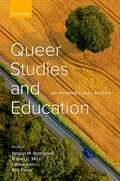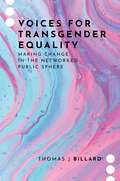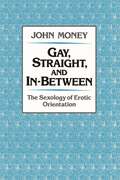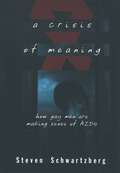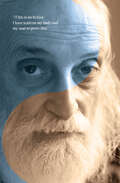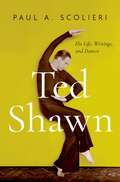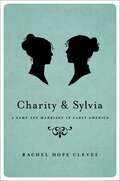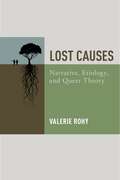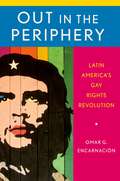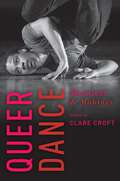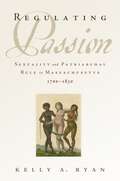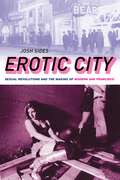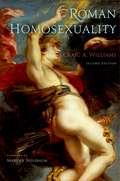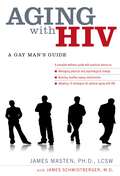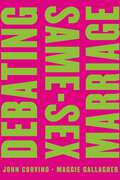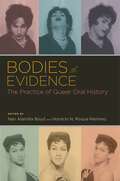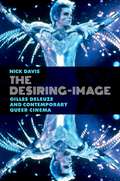- Table View
- List View
Queer Studies and Education: An International Reader
by Nelson M. Rodriguez, Robert C. Mizzi, Louisa AllenQueer Studies and Education: An International Reader explores how the category queer, as a critical stance or set of perspectives, contributes to opportunities individually and collectively for advancing (queer) social justice within the context and concerns of schooling and education. The collection takes up this general goal by presenting a cross-section of international perspectives on queer studies in education to demonstrate commonalities, differences, uncertainties, or pluralities across a diverse range of national contexts and topics, drawing a heightened awareness of heterodominance and heteropatriarchy, and to conceptualize non-normative and non-essentialist imaginings for more inclusive educational environments. Collectively, the chapters critically engage with heteronormativity and normativity more generally as a political spectrum, over a broad range of formal and informal sites of education, and against a backdrop of critiques of liberalism and neoliberalism as the frameworks through which "achievable" social change and belonging are fostered, particularly within educational settings. Taken together, the chapters assembled in Queer Studies and Education invite researchers, scholars, educators, activists, and other cultural workers to examine the multiplicity of contemporary (international) work in queer studies and education with readers' interpretations of queer's deployment across the chapters forming the compass for which to arrive at fresh insights and forms of (queer) critical praxis.
Voices for Transgender Equality: Making Change in the Networked Public Sphere (Journalism and Political Communication Unbound)
by Thomas J BillardTransgender rights have emerged as an important topic of everyday conversation across the country in recent years and become, in many ways, the flashpoint du jour of the American culture wars. During the Trump presidency in particular, transgender people were thrust onto the center stage of US politics. Faced with unrelenting hostility and an increasingly complicated media system, transgender activists crafted new communication strategies to fight for their equality, stall attempts to undermine their rights, and win the support of large swathes of the public. In Voices for Transgender Equality, Thomas J Billard offers an insider's view into transgender activism during the first two years of the Trump administration. Drawing on extensive on-the-ground observation at the National Center for Transgender Equality, Billard shows how these activists developed an unlikely blend of online and offline strategies to saturate a diverse ecology of national news outlets, local and community media outlets across the country, and both public and private conversations across multiple social media platforms with voices in support of their cause. Moreover, these activists navigated the complex flows of information and ideas among these different domains of the communication system as they worked to shape the national conversation on transgender rights. As Billard argues, this movement occurred at a very particular time in the development of the media system, with "new" media shaping the movement in important ways that are both generalizable to other social movements and unique to transgender activism. Including rich storytelling and insightful analysis, Voices for Transgender Equality makes a compelling case of what it takes to make social and political change in a world transformed by digital media. Along the way, Billard provides key insights into the new business-as-usual of mediated politics and valuable lessons for more effective activism.
Gay, Straight, and In-Between: The Sexology of Erotic Orientation
by John MoneyThe diverse historical, cultural, and physiological influences that determine sexual orientation are the focus of this fascinating work by one of the foremost investigators of human sexuality. Drawing on case studies from his sexology clinic, the author explores such topics as prenatal and postnatal history, gender differentiation in childhood, and postpubertal hormonal theories. In so doing, he addresses the many enigmas of sexual orientation: What makes some children grow up to be homosexual, while others become heterosexual or bisexual? To what degree is gender identity determined before birth? How do the concepts of masculine and feminine become differentiated during childhood? What do we know about the relationship between hormones and homosexuality in adulthood? A unique feature of this book is the follow-up reporting on Money's long-term studies that began over three decades ago. The studies are brought together here for comparison with one another--and with the work of others--and their full significance is systematically evaluated. Also explored here is his pioneering concepts of lovemaps, the pathways of individual sexual and erotic development, and the factors that may shape overall healthy or pathological orientation, paraphilia, and gender transposition in childhood, adolescence, and maturity. Written in accessible language for researchers and clinicians, this authoritative work is both thought-provoking and informative as it explores timely questions of sexual orientation.
A Crisis of Meaning: How Gay Men Are Making Sense of AIDS
by Steven SchwartzbergFor gay men, the demands of the AIDS epidemic are enormous and unrelenting. Regardless of HIV status, all are called on to maintain vigilant safety with sex, to face down a cultural stigma greater even than homophobia, and to somehow find a way to go forward in a world heavy with loss. As exhaustion and grief threaten to overwhelm the activism and optimism of earlier years, and with new infections on the rise among young gay men, the challenge of finding meaning in a world turned upside down is more than an idle philosophical exercise. It is a matter of psychological and perhaps even physical survival. In this poignant and uncompromising new book, Dr. Steven Schwartzberg offers a ground-breaking perspective on how gay men (and particularly HIV-positive gay men) find ways to rebuild a world of meaning amid the trauma and uncertainty of the AIDS crisis. Eschewing both glib prescriptions for turning tragedy into triumph, and theoretical abstractions, Schwartzberg grounds his insights in his own experiences as a gay man and as a practicing psychotherapist, and in in-depth interviews with nineteen men living with HIV. Ranging in age from twenty-seven to fifty, the men include a construction foreman, a physician, an art historian, a waiter, a librarian, and a licensed massage therapist. With candor, insight, eagerness, and a remarkable ability to share of themselves, they speak eloquently about how HIV has affected their views of the world, their senses of themselves, and how they live their lives. Interweaving the men's stories with observations from his research and clinical practice, Schwartzberg bears witness to the remarkable transformations some men have accomplished, and the anguish of meaninglessness that weighs others down. He strives to uncover why some view HIV as a catalyst for change or growth, while others see it only as punishment. And though he passes no judgment on the coping strategies he describes, Schwartzberg does insist on the vital necessity of balancing somber reality with healing, life-sustaining hope. He argues that men who opt for too much illusion and too little reality risk shoddy self-care and inadequate preparation for the future, while those who find no escape from reality may teeter into rage or suicidal despair. Beautifully written, with piercing awareness of the enormity of the challenges confronting individuals with HIV, this book celebrates the resilience of the human spirit. It is both a keen psychological guide and an elegiac chronicle of what life for many has become. Gently pointing the way to an oasis of growth, strength, and love that exists amid the epidemic's bleak terrain of loss, it is essential reading for people living with HIV, for their friends, families, and the mental health professionals who care for them, and for all gay men grappling with the enormous changes AIDS has brought to a community under siege.
Secret Writings of Hoshang Merchant
by Akshaya K. RathNever a shrinking violet, Hoshang Merchant came out of the closet early in his youth. A bard, a teacher, and a lover who has lived many lives, he is the quintessential gay who once cross-dressed, and yet defies categorization. In Secret Writings, he recounts his extraordinary life and splendid experiences ranging across countries and cultures. His is a story of the prejudice and neglect that are part of everyday gay life, and how he channelled his despair into creating poetry. He quotes Rumi, Ghalib, and Mir, and writes with searing honesty about his long and short love affairs, his ‘improbable’ sex life as both an initiator and a yielding partner, and his inner turmoil. Sex becomes love and love becomes poetry in his writing. Merchant yells at the moral guardians of law and culture, asks uncomfortable questions, and shocks his readers. This rare book opens a window to the myriad worlds of an avant-garde.
Ted Shawn: His Life, Writings, and Dances
by Paul A. ScolieriTed Shawn (1891-1972) is the self-proclaimed "Father of American Dance" who helped to transform dance from a national pastime into theatrical art. In the process, he made dancing an acceptable profession for men and taught several generations of dancers, some of whom went on to become legendary choreographers and performers in their own right, most notably his protégés Martha Graham, Louise Brooks, Doris Humphrey, and Charles Weidman. Shawn tried for many years and with great frustration to tell the story of his life's work in terms of its social and artistic value, but struggled, owing to the fact that he was homosexual, a fact known only within his inner circle of friends. Unwilling to disturb the meticulously narrated account of his paternal exceptionalism, he remained closeted, but scrupulously archived his journals, correspondence, programs, photographs, and motion pictures of his dances, anticipating that the full significance of his life, writing, and dances would reveal itself in time. Ted Shawn: His Life, Writings, and Dances is the first critical biography of the dance legend, offering an in-depth look into Shawn's pioneering role in the formation of the first American modern dance company and school, the first all-male dance company, and Jacob's Pillow, the internationally renowned dance festival and school located in the Berkshires. The book explores Shawn's writings and dances in relation to emerging discourses of modernism, eugenics and social evolution, revealing an untold story about the ways that Shawn's homosexuality informed his choreographic vision. The book also elucidates the influences of contemporary writers who were leading a radical movement to depathologize homosexuality, such as the British eugenicist Havelock Ellis and sexologist Alfred Kinsey, and conversely, how their revolutionary ideas about sexuality were shaped by Shawn's modernism.
Ted Shawn: His Life, Writings, and Dances
by Paul A. ScolieriTed Shawn (1891-1972) is the self-proclaimed "Father of American Dance" who helped to transform dance from a national pastime into theatrical art. In the process, he made dancing an acceptable profession for men and taught several generations of dancers, some of whom went on to become legendary choreographers and performers in their own right, most notably his protégés Martha Graham, Louise Brooks, Doris Humphrey, and Charles Weidman. Shawn tried for many years and with great frustration to tell the story of his life's work in terms of its social and artistic value, but struggled, owing to the fact that he was homosexual, a fact known only within his inner circle of friends. Unwilling to disturb the meticulously narrated account of his paternal exceptionalism, he remained closeted, but scrupulously archived his journals, correspondence, programs, photographs, and motion pictures of his dances, anticipating that the full significance of his life, writing, and dances would reveal itself in time. Ted Shawn: His Life, Writings, and Dances is the first critical biography of the dance legend, offering an in-depth look into Shawn's pioneering role in the formation of the first American modern dance company and school, the first all-male dance company, and Jacob's Pillow, the internationally renowned dance festival and school located in the Berkshires. The book explores Shawn's writings and dances in relation to emerging discourses of modernism, eugenics and social evolution, revealing an untold story about the ways that Shawn's homosexuality informed his choreographic vision. The book also elucidates the influences of contemporary writers who were leading a radical movement to depathologize homosexuality, such as the British eugenicist Havelock Ellis and sexologist Alfred Kinsey, and conversely, how their revolutionary ideas about sexuality were shaped by Shawn's modernism.
Charity and Sylvia: A Same-Sex Marriage in Early America
by Rachel Hope ClevesConventional wisdom holds that same-sex marriage is a purely modern innovation, a concept born of an overtly modern lifestyle that was unheard of in nineteenth century America. But as Rachel Hope Cleves demonstrates in this eye-opening book, same-sex marriage is hardly new. Born in 1777, Charity Bryant was raised in Massachusetts. A brilliant and strong-willed woman with a clear attraction for her own sex, Charity found herself banished from her family home at age twenty. She spent the next decade of her life traveling throughout Massachusetts, working as a teacher, making intimate female friends, and becoming the subject of gossip wherever she lived. At age twenty-nine, still defiantly single, Charity visited friends in Weybridge, Vermont. There she met a pious and studious young woman named Sylvia Drake. The two soon became so inseparable that Charity decided to rent rooms in Weybridge. In 1809, they moved into their own home together, and over the years, came to be recognized, essentially, as a married couple. Revered by their community, Charity and Sylvia operated a tailor shop employing many local women, served as guiding lights within their church, and participated in raising their many nieces and nephews. Charity and Sylvia is the intimate history of their extraordinary forty-four year union. Drawing on an array of original documents including diaries, letters, and poetry, Cleves traces their lives in sharp detail. Providing an illuminating glimpse into a relationship that turns conventional notions of same-sex marriage on their head, and reveals early America to be a place both more diverse and more accommodating than modern society might imagine, Charity and Sylvia is a significant contribution to our limited knowledge of LGBT history in early America.
Charity and Sylvia: A Same-Sex Marriage in Early America
by Rachel Hope ClevesConventional wisdom holds that same-sex marriage is a purely modern innovation, a concept born of an overtly modern lifestyle that was unheard of in nineteenth century America. But as Rachel Hope Cleves demonstrates in this eye-opening book, same-sex marriage is hardly new. Born in 1777, Charity Bryant was raised in Massachusetts. A brilliant and strong-willed woman with a clear attraction for her own sex, Charity found herself banished from her family home at age twenty. She spent the next decade of her life traveling throughout Massachusetts, working as a teacher, making intimate female friends, and becoming the subject of gossip wherever she lived. At age twenty-nine, still defiantly single, Charity visited friends in Weybridge, Vermont. There she met a pious and studious young woman named Sylvia Drake. The two soon became so inseparable that Charity decided to rent rooms in Weybridge. In 1809, they moved into their own home together, and over the years, came to be recognized, essentially, as a married couple. Revered by their community, Charity and Sylvia operated a tailor shop employing many local women, served as guiding lights within their church, and participated in raising their many nieces and nephews. Charity and Sylvia is the intimate history of their extraordinary forty-four year union. Drawing on an array of original documents including diaries, letters, and poetry, Cleves traces their lives in sharp detail. Providing an illuminating glimpse into a relationship that turns conventional notions of same-sex marriage on their head, and reveals early America to be a place both more diverse and more accommodating than modern society might imagine, Charity and Sylvia is a significant contribution to our limited knowledge of LGBT history in early America.
Lost Causes: Narrative, Etiology, and Queer Theory
by Valerie RohyCausality dominates today's discussions of LGBT rights: anti-gay voices imagine gay proliferation through seduction, influence, and corruption, while queer communities largely embrace biological determinism, saying they are "born gay." Reading popular rhetoric, psychoanalytic theory, and British and American literature from the late nineteenth century through the present day, Lost Causes decenters etiology from queer politics, engages abject tropes of "homosexual reproduction," and considers the effects of retroactive, absent, and contingent causality.
Out in the Periphery: Latin America's Gay Rights Revolution
by Omar G. EncarnaciónKnown around the world as a bastion of Catholicism and machismo, Latin America has emerged in recent years as the undisputed gay rights leader of the Global South. Even more surprising is that several Latin American nations have surpassed many developed nations, including the United States, in legislating equality for the LGBT community. So how did this dramatic and unexpected expansion of gay rights come about? And why are Latin American nations diverging in their embrace of gay rights, a point highlighted by the paradoxical experiences of Argentina and Brazil? Argentina, a country with a dark history of repression of homosexuality, legalized same-sex marriage in 2010, a first for a Latin American nation; and since then it has enacted laws to ensure transgender equality, to abolish "ex-gay reparative therapy," and to provide reproductive assistance to same-sex couples. By contrast, Brazil, a country famous for celebrating sexual diversity, proved incapable of legalizing same-sex marriage via the legislature, leaving the job to the courts; and Brazilian anti-gay discrimination laws are among the weakest in Latin America. In Out in the Periphery, Omar G. Encarnación breaks away from the conventional narrative of Latin America's embrace of gay rights as a by-product of the global spread of gay rights from the developed West. Instead, Encarnación aims to "decenter" gay rights politics. His intention is not to demonstrate how the "local" has trumped the "global" in Latin America but rather to suggest how domestic and international politics interacted to make Latin America one of the world's most receptive environments for gay rights. Economic and political modernization, constitutional and judicial reforms, and the rise of socially liberal governments have all contributed to this receptivity. But the most decisive factor was the skill of local activists in crafting highly effective gay rights campaigns. Inspired by external events and trends, but firmly grounded in local politics and realities, these campaigns succeeded in bringing radical change to the law with respect to homosexuality and, in some cases, as in Argentina, in transforming society and the culture at large.
Queer Dance
If we imagine multiple ways of being together, how might that shift choreographic practices and help us imagine ways groups assemble in more varied ways than just pairing another man with another woman? How might dancing queerly ask us to imagine futures through something other than heterosexuality and reproduction? How does challenging gender binaries always mean thinking about race, thinking about the postcolonial, about ableism? What are the arbitrary rules structuring dance in all its arenas, whether concert and social or commercial and competition, and how do we see those invisible structures and work to disrupt them? Queer Dance brings together artists and scholars in a multi-platformed project-book, accompanying website, and live performance series to ask, "How does dancing queerly progressively challenge us?" The artists and scholars whose writing appears in the book and whose performances and filmed interviews appear online stage a range of genders and sexualities that challenge and destabilize social norms. Engaging with dance making, dance scholarship, queer studies, and other fields, Queer Dance asks how identities, communities, and artmaking and scholarly practices might consider what queer work the body does and can do. There is great power in claiming queerness in the press of bodies touching or in the exceeding of the body best measured in sweat and exhaustion. How does queerness exist in the realm of affect and touch, and what then might we explore about queerness through these pleasurable and complex bodily ways of knowing?
Regulating Passion: Sexuality and Patriarchal Rule in Massachusetts, 1700-1830
by Kelly A. RyanSexuality was critical to how individuals experienced, learned, and contested their place in early America. Regulating Passion shows the sweeping changes that affected the social and political morass centered on sexual behavior during the late eighteenth and early nineteenth centuries in Massachusetts-even as patriarchy remained important to those configurations of power. Charting the government's and society's management of sexuality, Kelly A. Ryan uncovers the compelling stories of the individuals charged with sexual crimes and how elites hoped to contain and exploit "illicit" sexual behavior. In the colonial era, elites designed laws, judicial and religious practices, and sermons that defined certain groups as criminal, the cause of sexual vice, and in need of societal oversight-while defining others as chaste and above reproach. Massachusetts fornicators, adulterers, seducers, and rapists were exemplars of improper behavior in the colonial era and were central to emerging sexual subjectivities associated with gender, race, and class status in the early republic. As Massachusetts modernized, culture and socialization became vehicles for enforcing the marital monopoly on sex and gendered expectations of sexual behavior. The American Revolution saw the decline of direct sexual regulation by government and religious institutions and a rise in the importance of sexual reputation in maintaining hierarchy. As society moved away from publicly penalizing forms of illicit sexual behavior, it circulated ideas about sexual norms, initiated social ostracism, and interceded with family and friends to promote sexual morality, even as the government remained involved in cases of prostitution and interracial sex. At the same time, this transformation in sexual regulation opened up means to contest the power of patriarchy. Women, African Americans, Indians, and the poor often resisted the efforts of elites and established their own code of sexual conduct to combat ideas about what constituted sexual virtue and how society defined its leaders. They challenged derisive sexual characterizations, patriarchal visions of society, and sexual regulation to establish a space in the body politic. Ironically, their efforts often reinforced patriarchal ideals as their petitions asked for patriarchal privileges to be extended to them. Based on records of crimes in lower and upper courts, print literature, and other documentary sources, Regulating Passion underscores the ways in which sexual mores remained essential to the project of differentiating between the virtue of citizens and contesting power structures in the tumultuous transitions from the colonial to early national period.
Erotic City: Sexual Revolutions and the Making of Modern San Francisco
by Josh SidesSince the 1960s, San Francisco has been America's capital of sexual libertinism and a potent symbol in its culture wars. In this highly original book, Josh Sides explains how this happened, unearthing long-forgotten stories of the city's sexual revolutionaries, as well as the legions of longtime San Franciscans who tried to protect their vision of a moral metropolis. Erotic dancers, prostitutes, birth control advocates, pornographers, free lovers, and gay libbers transformed San Francisco's political landscape and its neighborhoods in ways seldom appreciated. But as sex radicals became more visible in the public spaces of the city, many San Franciscans reacted violently. The assassinations of Mayor George Moscone and Supervisor Harvey Milk were but the most brazen acts in a city caught up in a battle over morality. Ultimately, Sides argues, one cannot understand the evolution of postwar American cities without recognizing the profound role that sex has played. More broadly, one cannot understand modern American politics without taking into account the postwar transformation of San Francisco and other cities into both real and imagined repositories of unfettered sexual desire.
Roman Homosexuality: Second Edition
by Craig A. WilliamsTen years after its original publication, Roman Homosexuality remains the definitive statement of this interesting but often misunderstood aspect of Roman culture. Learned yet accessible, the book has reached both students and general readers with an interest in ancient sexuality. This second edition features a new foreword by Martha Nussbaum, a completely rewritten introduction that takes account of new developments in the field, a rewritten and expanded appendix on ancient images of sexuality, and an updated bibliography.
Aging with HIV: A Gay Man's Guide
by James MastenWith improvements in the treatment of HIV disease, gay men in great numbers are surviving--and thriving--into middle and older age. While increased longevity brings new hope, it also raises unanticipated challenges, particularly for gay men who never thought they would live this long: How do I deal with all the physical changes? Who can I rely on as I get older? Is a relationship still in the cards for me? What about sex? How should I prepare for old age? A one-of-a-kind guide for gay men aging with HIV, Aging with HIV offers an upbeat, down-to-earth approach for adapting to change, whether driven by age, AIDS, or both. Psychotherapist James Masten and physician James Schmidtberger shed light on the many common assumptions and fears of aging with HIV. Aging with HIV provides concrete solutions for facing midlife with a positive outlook, offering a wealth of advice for breaking unhealthy habits and coping mechanisms. The book describes the nine changes common to gay men as they age with HIV, discusses the four challenges of aging, and offers a unique ten-step path to optimal aging with HIV, helping the reader to tailor the book's suggestions to the realities of their lives. Woven throughout the book are first-person narratives from men who recount what worked--and did not work--for them. In addition, Rapid Research, Fast Fact, and Self-Reflection boxes highlight the latest research and challenge readers to take stock of the present--and plan for the future. An invaluable tool to keep handy and to refer to often, Aging with HIV is an inviting, confident companion to navigating midlife and beyond with HIV.
Aging with HIV: A Gay Man's Guide
by James MastenWith improvements in the treatment of HIV disease, gay men in great numbers are surviving--and thriving--into middle and older age. While increased longevity brings new hope, it also raises unanticipated challenges, particularly for gay men who never thought they would live this long: How do I deal with all the physical changes? Who can I rely on as I get older? Is a relationship still in the cards for me? What about sex? How should I prepare for old age? A one-of-a-kind guide for gay men aging with HIV, Aging with HIV offers an upbeat, down-to-earth approach for adapting to change, whether driven by age, AIDS, or both. Psychotherapist James Masten and physician James Schmidtberger shed light on the many common assumptions and fears of aging with HIV. Aging with HIV provides concrete solutions for facing midlife with a positive outlook, offering a wealth of advice for breaking unhealthy habits and coping mechanisms. The book describes the nine changes common to gay men as they age with HIV, discusses the four challenges of aging, and offers a unique ten-step path to optimal aging with HIV, helping the reader to tailor the book's suggestions to the realities of their lives. Woven throughout the book are first-person narratives from men who recount what worked--and did not work--for them. In addition, Rapid Research, Fast Fact, and Self-Reflection boxes highlight the latest research and challenge readers to take stock of the present--and plan for the future. An invaluable tool to keep handy and to refer to often, Aging with HIV is an inviting, confident companion to navigating midlife and beyond with HIV.
Debating Same-Sex Marriage (Point/Counterpoint)
by John Corvino Maggie GallagherPolls and election results show Americans sharply divided on same-sex marriage, and the controversy is unlikely to subside anytime soon. Debating Same-Sex Marriage provides an indispensable roadmap to the ongoing debate. Taking a "point/counterpoint" approach, John Corvino (a philosopher and prominent gay advocate) and Maggie Gallagher (a nationally syndicated columnist and co-founder of the National Organization for Marriage) explore fundamental questions: What is marriage for? Is sexual difference essential to it? Why does the government sanction it? What are the implications of same-sex marriage for children's welfare, for religious freedom, and for our understanding of marriage itself? While the authors disagree on many points, they share the following conviction: Because marriage is a vital public institution, this issue deserves a comprehensive, rigorous, thoughtful debate.
Bodies of Evidence: The Practice of Queer Oral History (Oxford Oral History Series)
by Nan Alamilla Boyd Horacio N. Roque RamirezBodies of Evidence: The Practice of Queer Oral History is the first book to provide serious scholarly insight into the methodological practices that shape lesbian, gay, bisexual, transgender, and queer oral histories. Each chapter pairs an oral history excerpt with an essay in which the oral historian addresses his or her methods and practices. With an afterword by John D'Emilio, this collection enables readers to examine the role memory, desire, sexuality, and gender play in documenting LGBTQ communities and cultures. The historical themes addressed include 1950s and '60s lesbian bar culture; social life after the Cuban revolution; the organization of transvestite social clubs in the U.S. midwest in the 1960s; Australian gay liberation activism in the 1970s; San Francisco electoral politics and the career of Harvey Milk; Asian American community organizing in pre-AIDS Los Angeles; lesbian feminist "sex war" cultural politics; 1980s and '90s Latina/o transgender community memory and activism in San Francisco; and the war in Iraq and Afghanistan. The methodological themes include questions of silence, sexual self-disclosure and voyeurism, the intimacy between researcher and narrator, and the social and political commitments negotiated through multiple oral history interviews. The book also examines the production of comparative racial and sexual identities and the relative strengths of same-sexuality, cross-sexuality, and cross-ideology interviewing.
Erotic City: Sexual Revolutions and the Making of Modern San Francisco
by Josh SidesSince the 1960s, San Francisco has been America's capital of sexual libertinism and a potent symbol in its culture wars. In this highly original book, Josh Sides explains how this happened, unearthing long-forgotten stories of the city's sexual revolutionaries, as well as the legions of longtime San Franciscans who tried to protect their vision of a moral metropolis. Erotic dancers, prostitutes, birth control advocates, pornographers, free lovers, and gay libbers transformed San Francisco's political landscape and its neighborhoods in ways seldom appreciated. But as sex radicals became more visible in the public spaces of the city, many San Franciscans reacted violently. The assassinations of Mayor George Moscone and Supervisor Harvey Milk were but the most brazen acts in a city caught up in a battle over morality. Ultimately, Sides argues, one cannot understand the evolution of postwar American cities without recognizing the profound role that sex has played. More broadly, one cannot understand modern American politics without taking into account the postwar transformation of San Francisco and other cities into both real and imagined repositories of unfettered sexual desire.
Roman Homosexuality: Second Edition
by Craig A. WilliamsTen years after its original publication, Roman Homosexuality remains the definitive statement of this interesting but often misunderstood aspect of Roman culture. Learned yet accessible, the book has reached both students and general readers with an interest in ancient sexuality. This second edition features a new foreword by Martha Nussbaum, a completely rewritten introduction that takes account of new developments in the field, a rewritten and expanded appendix on ancient images of sexuality, and an updated bibliography.
Bodies of Evidence: The Practice of Queer Oral History (Oxford Oral History Series)
by Nan Alamilla Boyd, Horacio N. Roque RamírezBodies of Evidence: The Practice of Queer Oral History is the first book to provide serious scholarly insight into the methodological practices that shape lesbian, gay, bisexual, transgender, and queer oral histories. Each chapter pairs an oral history excerpt with an essay in which the oral historian addresses his or her methods and practices. With an afterword by John D'Emilio, this collection enables readers to examine the role memory, desire, sexuality, and gender play in documenting LGBTQ communities and cultures. The historical themes addressed include 1950s and '60s lesbian bar culture; social life after the Cuban revolution; the organization of transvestite social clubs in the U.S. midwest in the 1960s; Australian gay liberation activism in the 1970s; San Francisco electoral politics and the career of Harvey Milk; Asian American community organizing in pre-AIDS Los Angeles; lesbian feminist "sex war" cultural politics; 1980s and '90s Latina/o transgender community memory and activism in San Francisco; and the war in Iraq and Afghanistan. The methodological themes include questions of silence, sexual self-disclosure and voyeurism, the intimacy between researcher and narrator, and the social and political commitments negotiated through multiple oral history interviews. The book also examines the production of comparative racial and sexual identities and the relative strengths of same-sexuality, cross-sexuality, and cross-ideology interviewing.
Regulating Passion: Sexuality and Patriarchal Rule in Massachusetts, 1700-1830
by Kelly A. RyanSexuality was critical to how individuals experienced, learned, and contested their place in early America. Regulating Passion shows the sweeping changes that affected the social and political morass centered on sexual behavior during the late eighteenth and early nineteenth centuries in Massachusetts-even as patriarchy remained important to those configurations of power. Charting the government's and society's management of sexuality, Kelly A. Ryan uncovers the compelling stories of the individuals charged with sexual crimes and how elites hoped to contain and exploit "illicit" sexual behavior. In the colonial era, elites designed laws, judicial and religious practices, and sermons that defined certain groups as criminal, the cause of sexual vice, and in need of societal oversight-while defining others as chaste and above reproach. Massachusetts fornicators, adulterers, seducers, and rapists were exemplars of improper behavior in the colonial era and were central to emerging sexual subjectivities associated with gender, race, and class status in the early republic. As Massachusetts modernized, culture and socialization became vehicles for enforcing the marital monopoly on sex and gendered expectations of sexual behavior. The American Revolution saw the decline of direct sexual regulation by government and religious institutions and a rise in the importance of sexual reputation in maintaining hierarchy. As society moved away from publicly penalizing forms of illicit sexual behavior, it circulated ideas about sexual norms, initiated social ostracism, and interceded with family and friends to promote sexual morality, even as the government remained involved in cases of prostitution and interracial sex. At the same time, this transformation in sexual regulation opened up means to contest the power of patriarchy. Women, African Americans, Indians, and the poor often resisted the efforts of elites and established their own code of sexual conduct to combat ideas about what constituted sexual virtue and how society defined its leaders. They challenged derisive sexual characterizations, patriarchal visions of society, and sexual regulation to establish a space in the body politic. Ironically, their efforts often reinforced patriarchal ideals as their petitions asked for patriarchal privileges to be extended to them. Based on records of crimes in lower and upper courts, print literature, and other documentary sources, Regulating Passion underscores the ways in which sexual mores remained essential to the project of differentiating between the virtue of citizens and contesting power structures in the tumultuous transitions from the colonial to early national period.
Debating Same-Sex Marriage (Point/Counterpoint)
by Maggie Gallagher John CorvinoPolls and election results show Americans sharply divided on same-sex marriage, and the controversy is unlikely to subside anytime soon. Debating Same-Sex Marriage provides an indispensable roadmap to the ongoing debate. Taking a "point/counterpoint" approach, John Corvino (a philosopher and prominent gay advocate) and Maggie Gallagher (a nationally syndicated columnist and co-founder of the National Organization for Marriage) explore fundamental questions: What is marriage for? Is sexual difference essential to it? Why does the government sanction it? What are the implications of same-sex marriage for children's welfare, for religious freedom, and for our understanding of marriage itself? While the authors disagree on many points, they share the following conviction: Because marriage is a vital public institution, this issue deserves a comprehensive, rigorous, thoughtful debate.
The Desiring-Image: Gilles Deleuze and Contemporary Queer Cinema
by Nick DavisThe Desiring-Image yields new models of queer cinema produced since the late 1980s, based on close formal analysis of diverse films as well as innovative contributions to current film theory. The book defines "queer cinema" less as a specific genre or in terms of gay and lesbian identity, but more broadly as a kind of filmmaking that conveys sexual desire and orientation as potentially fluid within any individual's experience, and as forces that can therefore unite unlikely groups of people along new lines, socially, sexually, or politically. The films driving this analysis range from celebrated fixtures of the New Queer Cinema of the 1990s (including Cheryl Dunye's The Watermelon Woman and Todd Haynes's Velvet Goldmine) to sexually provocative films of the same era that are rarely classified as queer (David Cronenberg's Dead Ringers and Naked Lunch) to breakout films by 21st-century directors (Rodney Evans's Brother to Brother, John Cameron Mitchell's Shortbus). To frame these readings and to avoid heterosexist assumptions in other forms of film analysis, The Desiring-Image revisits the work of the philosopher Gilles Deleuze, whose two major works on cinema somehow never address the radical ideas about desire he expresses in other texts. This book brings those notions together in innovative ways, making them clear and accessible to newcomers and field specialists alike, with clear, illustrated examples drawn from a wide range of movies extending beyond the central case studies. Thus, The Desiring-Image speaks to readers interested in queer and gay/lesbian studies, in film theory, in feminist and sexuality scholarship, and in theory and philosophy, putting those discourses into rich, surprising conversations with popular cinema of the last 30 years.
